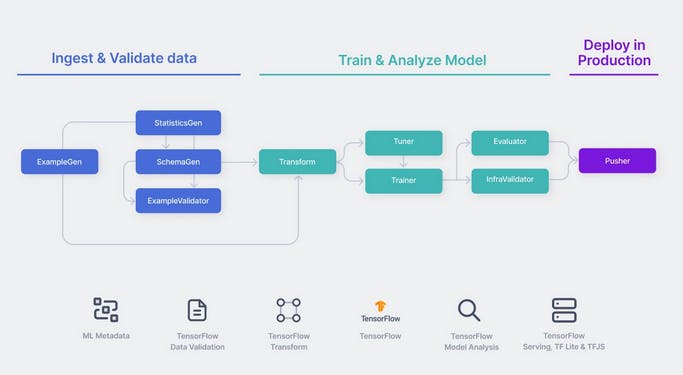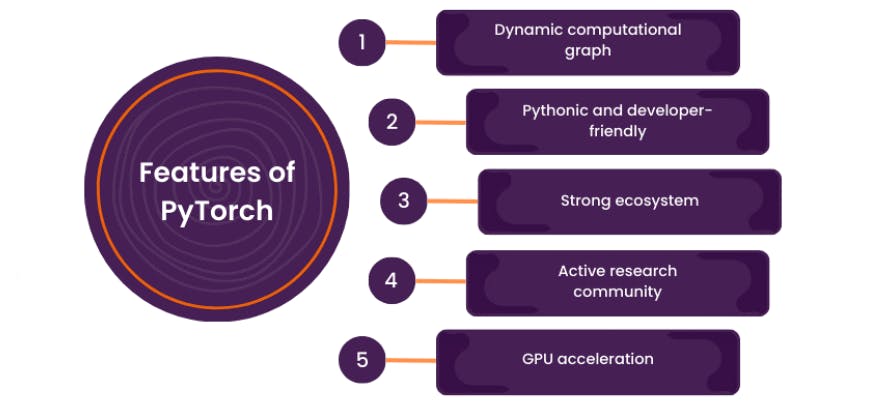What are the strengths and use cases of TensorFlow and PyTorch in the context of AI automation?
TensorFlow vs. PyTorch: Unveiling the Powerhouses of AI Automation
Introduction
In the dynamic landscape of artificial intelligence (AI), two frameworks have risen to prominence, each with its unique strengths and fervent developer communities – TensorFlow and PyTorch. This comprehensive article navigates the strengths and use cases of these powerhouses in the context of AI automation, unraveling the intricacies that make them essential players in shaping the future of intelligent systems.
Understanding TensorFlow
TensorFlow: A Brief Overview:
Embark on a journey through TensorFlow's origins, exploring how it evolved from an internal project at Google to an open-source giant. Dive into the core concepts of tensors and computational graphs that form the foundation of TensorFlow's architecture.
Strengths of TensorFlow:
Uncover TensorFlow's strengths, from its extensive ecosystem of pre-trained models and modules to its scalability and deployment options. Explore how TensorFlow Serving and TensorFlow Lite cater to various deployment scenarios, from cloud-based solutions to edge devices.
TensorFlow for Deep Learning:
Delve into TensorFlow's prowess in deep learning. Explore its capabilities for building complex neural networks, its compatibility with GPUs and TPUs for accelerated training, and how TensorFlow 2.x simplifies the development process with eager execution.
TensorFlow Extended (TFX) for End-to-End ML Pipelines:
Discover TensorFlow Extended (TFX), an end-to-end platform for deploying production-ready machine learning (ML) models. Understand how TFX streamlines ML pipelines, covering everything from data validation to model deployment, ensuring robust automation in real-world scenarios.
Use Cases of TensorFlow

Image and Speech Recognition:
Explore TensorFlow's role in image and speech recognition applications. From the inception of Convolutional Neural Networks (CNNs) to the use of Transfer Learning with models like Inception and MobileNet, TensorFlow excels in understanding and processing visual and auditory information.
Natural Language Processing (NLP):
Dive into TensorFlow's applications in Natural Language Processing (NLP). Uncover how models like BERT and GPT-2, implemented with TensorFlow, have revolutionized language understanding tasks, from sentiment analysis to language translation.
Reinforcement Learning:
Witness TensorFlow's foray into reinforcement learning. Understand its contributions to developing and training agents for complex tasks, from playing games to navigating real-world environments, showcasing the versatility of TensorFlow in dynamic decision-making scenarios.
Understanding PyTorch
PyTorch: A Brief Overview:
Embark on the PyTorch journey, tracing its roots from Facebook's AI Research lab. Explore PyTorch's dynamic computational graph, which differentiates it from TensorFlow, providing flexibility and ease of debugging during model development.
Strengths of PyTorch:
Uncover PyTorch's strengths, from its intuitive and Pythonic interface to its dynamic computation graph that simplifies model building and debugging. Explore how PyTorch's eager execution mode enhances the development experience and facilitates experimentation.
PyTorch for Research and Experimentation:
Delve into PyTorch's strong presence in the research community. Explore how its dynamic graph and seamless integration with popular libraries like NumPy make it a preferred choice for researchers and developers engaged in cutting-edge AI experiments.
TorchScript for Deployment:
Discover TorchScript, PyTorch's solution for model deployment. Understand how TorchScript provides a way to serialize and optimize PyTorch models for production environments, enabling seamless integration with a variety of deployment scenarios.
Use Cases of PyTorch

Computer Vision and Image Processing:
Explore PyTorch's applications in computer vision. From building custom image classifiers to implementing advanced object detection models like Faster R-CNN, PyTorch's flexibility and dynamic nature make it a preferred choice for vision-related tasks.
Generative Models and Style Transfer:
Dive into PyTorch's role in generative models and style transfer applications. Understand how models like Generative Adversarial Networks (GANs) and Neural Style Transfer have been implemented with PyTorch, showcasing its capability in creating artistic and creative outputs.
Transfer Learning for Custom Tasks:
Witness PyTorch's prowess in transfer learning. Explore how pre-trained models, such as those from the torchvision library, can be fine-tuned for custom tasks, allowing developers to leverage the knowledge encoded in large-scale datasets.
Comparative Analysis
TensorFlow vs. PyTorch:
Flexibility and Ease of Use:
Compare the flexibility and ease of use between TensorFlow and PyTorch. Understand how PyTorch's dynamic computational graph and intuitive syntax appeal to developers for rapid prototyping and experimentation.
Scalability and Deployment:
Explore the scalability and deployment considerations for both frameworks. Analyze TensorFlow's TensorFlow Extended (TFX) and PyTorch's TorchScript, understanding how each addresses the challenges of deploying AI models at scale.
Community and Industry Adoption:
Dive into the communities surrounding TensorFlow and PyTorch. Explore their strengths, from TensorFlow's wide industry adoption in production systems to PyTorch's stronghold in the research community and its increasing popularity in industry applications.
Challenges and Considerations

TensorFlow's Learning Curve:
Address TensorFlow's reputation for having a steeper learning curve compared to PyTorch. Understand how TensorFlow 2.x has made strides in improving user-friendliness and whether this perception holds true in practice.
PyTorch's Production Deployment:
Explore challenges related to PyTorch's historical perception as being more suitable for research than production. Understand how recent developments, including TorchScript, aim to bridge this gap and make PyTorch more production-friendly.
Future Trends and Outlook
On-Device AI and Edge Computing:
Explore the future trends in on-device AI and edge computing. Understand how both TensorFlow and PyTorch are positioning themselves to play a significant role in pushing AI capabilities to the edge.
Quantum Machine Learning Integration:
Dive into the emerging trend of quantum machine learning. Explore how TensorFlow and PyTorch are exploring ways to integrate with quantum computing frameworks, paving the way for enhanced computational power in AI models.

Conclusion
As we navigate the ever-evolving landscape of AI automation, TensorFlow and PyTorch stand tall as pillars of innovation, each bringing its unique strengths to the table.
Whether it's TensorFlow's scalability and deployment prowess or PyTorch's flexibility and research-friendly interface, both frameworks continue to shape the future of intelligent systems.
The choice between TensorFlow and PyTorch often boils down to the specific needs of the project, the development team's preferences, and the nature of the application being built.
Ultimately, as AI automation continues to revolutionize industries, both TensorFlow and PyTorch will remain indispensable tools in the arsenal of AI developers, driving advancements and breakthroughs in the field. 🚀🤖💻
For more insights into AI|ML and Data Science Development, please write to us at: contact@htree.plus | F(x) Data Labs Pvt. Ltd.
#AITitans #TensorFlowVsPyTorch #AIInnovation #TechShowdown
